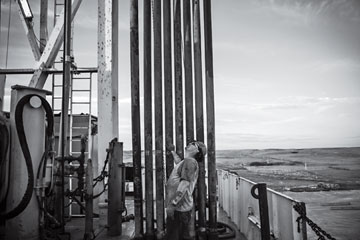
Fracking has unlocked new oil supplies in states like North Dakota, reducing crude imports.
(5 of 6)
A green future hasn't arrived yet--solar still accounts for less than 1% of the total energy consumed in the U.S., and dumb meters still outnumber smart ones. But there's another boom, little noticed, that's already under way in the nation: efficiency. When the Middle East oil embargo struck in 1973, the average vehicle got just 11.9 miles per gallon. Today the U.S. uses less oil as a whole than it did 40 years ago, when the economy was a third of its current size. Some of that shift is due to deindustrialization and the end of oil-fired power plants, but the amount of crude-based distillates used in vehicles, homes and businesses has declined as well, down 14% last year from a peak in 2005. The growth in electricity demand has fallen behind growth in population, as everything--from TVs to refrigerators--has become more efficient.
Under Obama, Washington has dialed up efficiency in a big way. The corporate average fuel efficiency standard, which governs auto gas mileage, will rise to 35.5 m.p.g. in 2016 and 54.5 m.p.g. by 2025, enough to save 12 billion barrels of oil over the lifetime of the regulation. A decade after a cascading power failure led to a major blackout in the Northeast, the electrical grid is stronger and more resilient. Smart software can identify where energy waste is occurring, allowing utilities to reduce power use during peak periods like hot summer days, which in turn means fewer power plants need to be built and operated. All told, the U.S. gets twice as much economic value out of a single unit of energy today as it did in 1980, and we'll keep getting more in the future. "You can look at natural gas, nuclear, new oil drilling," says Ralph Cavanagh, a co-director of the energy program at the Natural Resources Defense Council, "and all of it together is less important than energy efficiency."
Gambling With the Earth
In 1980 biologist and environmental icon Paul Ehrlich and conservative economist Julian Simon made a simple wager. Ehrlich bet that the price of five common metals would rise over the next decade, and Simon bet that the price would fall, with the loser paying the price change on a $1,000 bundle of the five metals. The bet was really a contest of visions. Ehrlich--a neo-Malthusian best known for his 1968 book The Population Bomb--believed that rising prices for materials would show that the world was headed toward scarcity and catastrophe. Simon believed that human creativity would always find ways to make basic resources cheaper and more widely available.
In 1990, Simon won the bet (and $576.07 from Ehrlich). Ever since, his vision has prevailed. Scarcity, by and large, gave birth to the new technologies that have ushered the U.S. into a time of relative energy abundance. Geology didn't decide our destiny. Human ingenuity did. "Today we've got booming production of oil and natural gas, rapidly falling oil consumption and rising renewable energy," says Michael Levi, a senior fellow at the Council on Foreign Relations. "It's not just one boom. It's several at the same time."
